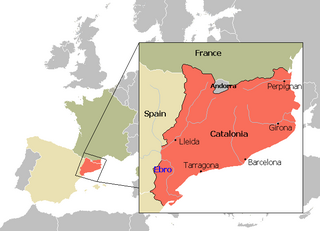
Barcelona is a city on the northeastern coast of Spain. It is the capital and largest city of the autonomous community of Catalonia, as well as the second-most populous municipality of Spain. With a population of 1.6 million within city limits, its urban area extends to numerous neighbouring municipalities within the province of Barcelona and is home to around 5.3 million people, making it the fifth most populous urban area of the European Union after Paris, the Ruhr area, Madrid and Milan. It is one of the largest metropolises on the Mediterranean Sea, located on the coast between the mouths of the rivers Llobregat and Besòs, bounded to the west by the Serra de Collserola mountain range.

Catalonia is an autonomous community of Spain, designated as a nationality by its Statute of Autonomy. Most of its territory is situated on the northeast of the Iberian Peninsula, to the south of the Pyrenees mountain range. Catalonia is administratively divided into four provinces or eight vegueries (regions), which are in turn divided into 42 comarques. The capital and largest city, Barcelona, is the second-most populous municipality in Spain and the fifth-most populous urban area in the European Union.

The recorded history of the lands of what today is known as Catalonia begins with the development of the Iberian peoples while several Greek colonies were established on the coast before the Roman conquest. It was the first area of Hispania conquered by the Romans. It then came under Visigothic rule after the collapse of the western part of the Roman Empire. In 718, the area was occupied by the Umayyad Caliphate and became a part of Muslim ruled al-Andalus. The Frankish Empire conquered northern half of the area from the Muslims, ending with the conquest of Barcelona in 801, as part of the creation of a larger buffer zone of Christian counties against Islamic rule historiographically known as the Marca Hispanica. In the 10th century the County of Barcelona became progressively independent from Frankish rule.

The Catalan independence movement is a social and political movement which seeks the independence of Catalonia from Spain.

The Principality of Catalonia was a medieval and early modern state in the northeastern Iberian Peninsula. During most of its history it was in dynastic union with the Kingdom of Aragon, constituting together the Crown of Aragon. Between the 13th and the 18th centuries, it was bordered by the Kingdom of Aragon to the west, the Kingdom of Valencia to the south, the Kingdom of France and the feudal lordship of Andorra to the north and by the Mediterranean Sea to the east. The term Principality of Catalonia was official until the 1830s, when the Spanish government implemented the centralized provincial division, but remained in popular and informal contexts. Today, the term Principat (Principality) is used primarily to refer to the autonomous community of Catalonia in Spain, as distinct from the other Catalan Countries, and usually including the historical region of Roussillon in Southern France.

The Museu Picasso is an art museum in Barcelona, in Catalonia, Spain. It houses an extensive collection of artworks by the twentieth-century Spanish artist Pablo Picasso, with a total of 4251 of his works. It is housed in five adjoining medieval palaces on Montcada Street in the La Ribera neighborhood in the Old City of Barcelona. It opened to the public on 9 March 1963, becoming the first museum dedicated to Picasso's work and the only one created during his lifetime. It has since been declared a museum of national interest by the Government of Catalonia.
The following is a timeline of the history of the city of Madrid, Spain.
The following is a timeline of the history of Havana, Cuba.
The following is a timeline of the history of the city of Lima, Peru.
The following is a timeline of the history of the city of Seville, Andalusia, Spain.
The following is a timeline of the history of the city of Málaga, Andalusia, Spain.
The following is a general historical timeline of the city of Los Angeles, California in the United States of America.
The following is a timeline of the history of the city of Florence, Tuscany, Italy.
The following is a timeline of the history of the city of Palma, Spain.
The following is a timeline of the history of the city of Burgos, Spain.
The following is a timeline of the history of the city of Lleida in Catalonia, Spain.
The following is a timeline of the history of the city of Alicante, Spain.
The following is a timeline of the history of the city of Jaén, Spain.
This is a timeline of Catalan history, comprising important legal and territorial changes and political events in Catalonia and its predecessor states and polities. To read about the background to these events, see History of Catalonia.

The Catalan Republic was a state proclaimed in 1931 by Francesc Macià as the "Catalan Republic within the Iberian Federation", in the context of the proclamation of the Second Spanish Republic. It was proclaimed on 14 April 1931, and superseded three days later, on 17 April, by the Generalitat de Catalunya, the Catalan institution of self-government within the Spanish Republic.









